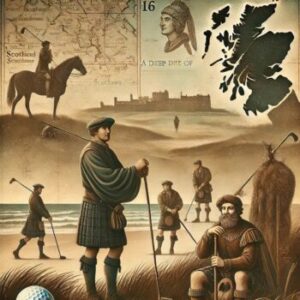The origin story of golf, one of the most popular sports that is played by millions across continents, is quite rich and rather controversial. Although games of a similar nature date as far back as ancient Rome and China, the form of the game most familiar to people today certainly developed well in Scotland.
It is this windswept terrain that brought golf its nature, its shape and its lasting cultural connections that even now influence the game centuries down the line.

Scotland’s Role in Shaping Golf
Although previous societies practised similar activities, it is in Scotland in the 15th century that golf started to develop as an organised sport. The first written mention is of an Act of the Scottish Parliament in 1457, which forbade golf (and football) as a distraction to the practice of archery by soldiers.
Nonetheless, golf became popular despite this ban. The ban was lifted by King James IV by the early 1500s, and he publicly announced that he was a fan of sports, therefore making it a sport of nobility.
At this time, primitive clubs and balls were evolving toward their present form. The common set of irons you see in a Sunday golf bag would have clubs that were in a wide range of lies and distances, made of hand-forged steel and paired with wooden shafts.
These primitive versions did not offer any consistency, although they were the precursors to the present-day high-performance, technologically advanced sets.
The First Golf Courses and Clubs
Formal courses were created due to the appearance of special playing fields. One of the earliest recognised venues was St Andrews, which is now legendary in the history of the game. By the mid-16th century, golf was played at the Old Course in St Andrews over 22 holes, which was later shortened to 18 holes in 1764- a layout that would subsequently become the international standard.
The organisations, known as golf clubs, started to be formed too. The earliest golf club, the 1744 Honourable Company of Edinburgh Golfers, is generally regarded as the first golf club in the world. They made some of the first written rules and made competition and etiquette uniform.
From Local Favour to Global Phenomenon
The spread of golf beyond Scotland was gradual yet inevitable. British soldiers and merchants brought the sport to far-flung parts of the Empire. By the 1800s, courses had been established in India, South Africa, and Australia. As trade and colonial influence expanded, so did golf’s reach.
In the United States, the game gained traction in the late 19th century, with the establishment of the first 18-hole course at the Chicago Golf Club in 1893. The United States Golf Association (USGA) followed in 1894, promoting rules and competitive play in line with Scottish standards.
The Birth of the Professional Game
While golf began as a leisure activity for the elite, the professional side of the sport gradually emerged. Caddies and club-makers, often of lower social status, started to play competitively for money. This shift laid the foundation for the creation of professional tournaments.
The first major professional tournament was the Open Championship, inaugurated in 1860 at the Prestwick Golf Club. Over time, other major events such as the U.S. Open, The Masters and the PGA Championship came into being and more and more talents and fans from the world over were drawn to them.
Technological Evolution and Modern Appeal
Innovation has transformed the playing pattern of the game. Clubs made of wood turned into graphite-shafted drivers and stainless-steel irons. Golf balls went from the feather-stuffed leather to multi-layered and high-velocity balls. The modern golf player has been affected by training approaches, statistical monitoring and biomechanics.
Telecasts, endorsements and sponsorships have added more value to the sport, enhancing golf to become a commercial giant. This sport, which started as a Scottish noble hobby, has now grown into an international game with a well-developed professional league and an enormous pool of amateur players.
A Legacy of Tradition and Transformation
The longstanding heritage of golf is its tradition that balances innovation. Sheep-grazed Scotland to competition courses in Dubai, the sport has been developing, yet keeping the memory of its roots.
A game started by a few holes in the dunes at St Andrews has grown to be a global pursuit, but to hit the ball with a club, even in the era of technological advancement, still rings a history of centuries.